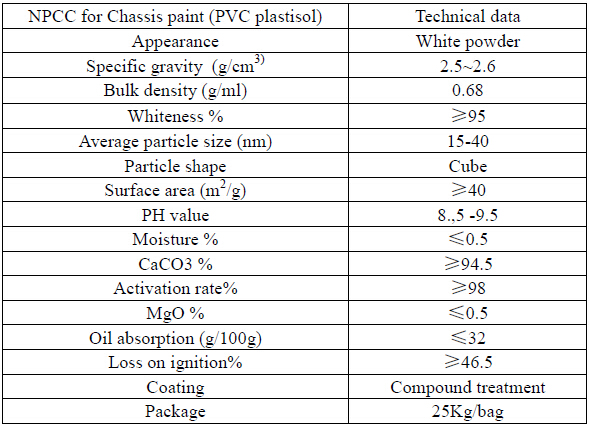2112-T belongs to one model of our production of NPCC for Chassis paint (PVC plastisol), it is applied in the Chassis paint (PVC plastisol) industry.
Because of NPCC for Chassis paint (PVC plastisol) (Nano calcium carbonate<Nano-precipitated calcium carbonate>) nanometer size effect, large specific surface area, surface atoms at a high activation state and the interface with the polymer has a high interaction, when added to paint, it can be get any special modified paint’s function. Good thixotropy of NPCC for Chassis paint (PVC plastisol), it can be used in chassis rock attack paint and face paint.
The car is in moving process, the vehicle and wheel fenders, etc. often were impacted and scoured by sand, grave and son, thus the coating sprayed on the substrate easily damaged, while loss corrosion resistance, the substrate will soon corrosion wear bad. To solve this problem, you can to spray anti-shock and anti-corrosion coating on it. PVC plastisol is one kind of chasis paint, mainly constituted by the PVC paste resin, plasticizer, filler (nano-precipitated calcium carbonate), stabilizing agent, tackifier, solvent and other additives composition. The amount of NPCC is approximately 30% (specific amount of formula should be based), while the addition of NPCC to normal, NPCC will be larger than the average degree of improvement of rheological properties and film impact resistance.
In the process of spray paint, chassis paint should be required to achieve easy to spray, low viscosity, fluidity and viscosity after construction requirements to prevent stick down and sagging. This requires coating at high shear rate, the viscosities were lowered, you can easily spray leveling, in low shear speed or stationary state with high viscosity to prevent coating sink to the bottom and sagging. This property of paint is called thixotropy and NPCC in construction performance, structural performance can satisfy this requirement.
The nanometer calcium carbonate for Chassis paint (PVC plastisol) has the following characteristics:
1. with a high degree of activation.
2. with high yield stress.
3. with good thixotropy.
Specification
Sheet


